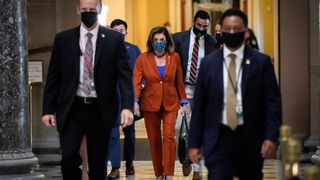Votes on President Biden’s agenda in Congress may be imminent – and at stake is the future of Biden’s presidency. Issues Australia cares about are in the balance too.
Democrats in the United States Congress have a very straightforward choice to make: either enact Biden’s sweeping program to revitalise American society with policies across education, health care, jobs, infrastructure, childcare and security for seniors, renewable energy and climate change or they can fail. Then Joe Biden’s presidency, and the hopes of Democrats plus tens of millions of other Americans over the past two generations since Ronald Reagan’s election, will come to a screeching halt.
Biden would become a lame duck and the Democrats up for election next year in the House and Senate would become sitting ducks for a Republican Party ever-more dominated by Donald Trump. This isn’t Trump’s ghost, but the unrepentant and emboldened former president.
When Biden assumed office and assembled his team in the White House, they were all determined to govern with the benefit of the searing lessons learned 12 years earlier in Barack Obama’s first term: Go big, go early, go fast.
To address controlling the COVID pandemic and the ongoing economic catastrophe he knew to go big, go early, go fast. As he took office, Obama faced the Great Financial Crisis recession of 2008-9. His rescue plan was whittled down by Senate Republicans to well below US$1 trillion. It worked – but too slowly, with steady but low economic and jobs growth. Obama was punished by the voters in the 2010 midterms, losing over 60 seats and control of the House, because the economy did not fire enough. Within his first 50 days, Biden had rammed through Congress, with no Republican support, US$1.9 trillion in COVID aid and economic stimulus. And it’s working. Economy and jobs growth are at a pace unmatched in decades.
To address major social programs in health, education and climate, he again went big, early and fast. It took Obama 14 months – until March 2010 – to pass Obamacare. Global warming legislation died in the Senate 18 months into his first term. Voters did not see any major benefits from Obamacare by the 2010 midterm elections and action on climate change was slowed significantly.
Biden carried these lessons to their relentless political conclusion.
All of Biden’s economic and social programs are packaged in two bills: a bipartisan agreement, which passed the Senate, on a US$1 trillion infrastructure package and a US$2+ trillion package encompassing climate, health, education and support for children and seniors. They are large enough to make a difference in the quality of life across society that will be felt throughout 2022 in the runup to the midterm elections that November. This huge initiative – on par with FDR’s New Deal and LBJ’s Great Society – is financed principally by tax increases on the rich and higher corporate taxes.
Among Democrats there is an understanding that both must pass. The infrastructure bill is the largest of its type since the interstate highway system was built in the 1950s and ‘60s. While necessary, it is not sufficient to fulfill the platform Democrats embraced and Joe Biden was elected on.
Progressives in the party in both the House and Senate will not vote for the infrastructure bill unless their colleagues pass the broader reconciliation measure on urgent priorities including health, education and climate. And the obverse is true for Democratic moderates: unless infrastructure passes, there is no hope on the major program.
With a margin of three votes in the House and zero in the Senate, all the Democrats must vote together.
What makes this reckoning on the scope of policy and political unity possible?
From Ronald Reagan through Bill Clinton, a broad consensus prevailed on the size and scope of the role of government. The Reagan Revolution was about smaller government, tax cuts to reward the private sector and suppress government spending, and reduced regulation. It was Clinton, governing under this paradigm, who balanced the budget, and famously declared – as a winning proposition for a Democrat –that “The era of big government is over.”
COVID-19 has confronted advanced democracies worldwide with the reality that robust and effective government is essential to confront such a catastrophic crisis. Coupled with the failings of American society in the quality of schools, health, employment income, security in retirement, and infrastructure from roads and airports to digital highways, there is window open at this unique moment. The mindset in the broad electorate has shifted, with most Americans thinking the rich are getting too much and the middle really needs help, and America desperately needs rebuilding.
What Biden is proposing on infrastructure, social programs and taxes is not seen as radical, but as responsible, pragmatic, fair.
This is why virtually all the polling on the Biden agenda is quite positive even among Republican voters.
If the infrastructure program is enacted, on top of the rescue bill and expansions to health care, education and income security programs, real results may be apparent early in 2022. Then the killer midterm history for the incumbent party in the White House, where they lose on average two dozen seats, may not recur next year.
Therefore, the Democrats are insistent this get done. Biden wants – and needs – to show the country, and the world, that American democracy can work again. And Democrats need to show the Congress they lead can do big things. Because they cannot win the midterms if they cannot govern.
If they cannot pass this legislation in the coming days, Democrats will fail to unite in the Senate to change its super-majority filibuster rules that stand to stymie the social justice pieces they stand for: voting rights protection, gun control, police reform and immigration.
So, this is it. Unite and vote or divide and be conquered.
Democrats could deliver a victorious president with a renewed mandate to lead at home and abroad. If not, they will ensure a deeply wounded president, with approval ratings that will stay well below 50 per cent, with no hope of any more major legislative programs for the balance of his term. He will be all-but-certain to face a Trumpist Republican House of Representatives in 2023 determined to neuter his effectiveness, almost surely impeach him, and, for the presidency in 2024, spur a landmark defeat by Trump or a candidate claiming his mantle.
What could this mean for Australia? A strong president at home brings strength to AUKUS. A weak president means countries around the world – allies, competitors and enemies – perceive they are facing an America with less strategic weight.
In these fateful days, it is Democrats who will decide Biden’s fate – and their own. It’s all on the line for the Biden presidency and by the end of this week, we will know which course lays ahead.






